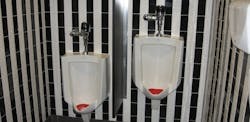About the author: Jeff Arnold is water treatment manager for Watertronics Inc. Arnold can be reached at [email protected] or 262.337.2567.
Located in the Logan Square neighborhood on Chicago’s north side, Haas Park is a testament to the city’s commitment to sustainability through appropriate use of rainwater harvesting.
Haas Park honors Joseph F. Haas (1857-1928), a widely respected public servant. During his 42-year career in public office, he served as a Chicago alderman, secretary of the sanitary district, state senator and more.
The city purchased the land for the park just two months after Haas' death. At the time, the surrounding Logan Square neighborhood was in the midst of a residential building boom and open space was quickly disappearing. The new park included a small recreational building with an open-air shelter house. The city transferred the park site to the Chicago Park District (CPD) in 1959.
Aiming for Efficiency
Logan Square is now served by the park's new fully accessible 10,244-sq-ft fieldhouse. The single-story building, which targeted to achieve the U.S. Green Building Council's Leadership in Energy and Environmental Design (LEED) Gold certification, includes a half-size gymnasium, a fitness center and community rooms. The building is designed to achieve maximum efficiency with the use of natural light, rainwater harvesting, a living "green" roof and geothermal mechanical systems.
"The PBC [Public Building Commission of Chicago] plans, designs and builds facilities that reflect the highest standards of environmental and economic sustainability," said Mimi Simon, public information officer for the PBC. "Projects built by the Public Building Commission are designed to achieve LEED Silver certification or better, with LEED Gold certification achieved for most park district fieldhouses. The overarching goal is to optimize resource efficiency—water and energy savings and storm water management—to align with city of Chicago climate goals and citizen concerns in a way that can be reasonably operated and maintained."
Treatment & Reuse
The park implemented a SkyHarvester system from Watertronics Inc., a Lindsay Co., which gathers water from the building's green roof. The harvested rainwater then goes through prefiltration and into an outdoor belowground storage tank.
"Water harvesting saves potable water and keeps clean rainwater out of Chicago’s combined sewers, reducing costs to pump and treat water at both ends—potable and sewage," Simon said. "It also reduces sewer loads and thus contribution to combined sewer overflows."
A pump station delivers rainwater to the building’s toilet system after it has been filtered and treated with chlorine. First, water is transferred from the outdoor storage tank into the mechanical room via a Watertronics transfer pump and is stored in what is called a "day tank." During transfer, the water goes through a bag filter that filters to the 50-μ level.
Chlorination takes place in the day tank. The chlorinator and recirculation pump constantly mix a chlorine solution into the tank. The harvested rainwater is continuously recirculated, and residual chlorine is measured to ensure adequate disinfection. The water is tested by a chlorine analyzer, and based on the residual level, the chlorinator automatically adjusts dosing to meet the desired set-point.
The water is then ready for final delivery by the main Watertronics duplex pump system for its intended use: toilet flushing. The pump station starts via a pressure drop sensed in the water distribution system, which regulates a constant pressure at variable flow rate. This is done with a programmable logic controller and variable frequency drive control system for maximum energy efficiency and pump station longevity.
"Water harvesting for flushing toilets and urinals, and high-efficiency plumbing, allowed us to reduce potable water use within the Haas Park fieldhouse by an estimated 39% over baseline, cycling rainwater through flush fixtures instead of potable water," Simon said.
"As a public developer and as a responsible steward of the public fund, the PBC focuses on sustainability—not just environmental sustainability, but also economic sustainability," Simon added. "These two goals are linked, because when we include elements of environmentally sustainable design in our projects, it lowers life-cycle costs, reduces costs for utilities and minimizes the drain of our natural resources."
Special Considerations
The rainwater harvesting system also had to be designed with replenishment water from a municipal supply. In the event that the outdoor storage tank is empty of rainwater, municipal water is routed directly to the day tank and the main tank awaits refilling by the next rain event. Once the water level returns to normal in the outdoor storage tank, the municipal water valve shuts off and the system pulls from the harvested water instead.
Watertronics engineers had to build a pump station that could be easily assembled and disassembled onsite due to the space limits of the mechanical room, which included a 30-in. doorway. The system was designed to ship as a single unit and be easily disassembled into modular components and seamlessly reassembled inside the mechanical room. The pump station is capable of delivering rainwater to the distribution system at 60 gal per minute and 35 psi.
On the park grounds, the community will find a newly renovated Americans With Disabilities Act-accessible playground, along with a water spray feature. In addition, there is a large open green space, ideal for special events such as picnics or CPD's Movies in the Park events.
"It is likely that we will use water-harvesting systems in future projects," Simon said. "Although water costs are not high in Chicago, we are very conscious of our role in responsible stewardship of the great resource we have in Lake Michigan, and of the combined sewer and need to reduce storm water loads. Both of these factors, as well as our commitment to lead by example, contribute to the city’s decision to pursue water reuse. In fact, our efforts to date have helped shift plumbing codes by providing precedent for water reuse systems in Chicago that can be applied to other projects."
Download: Here
